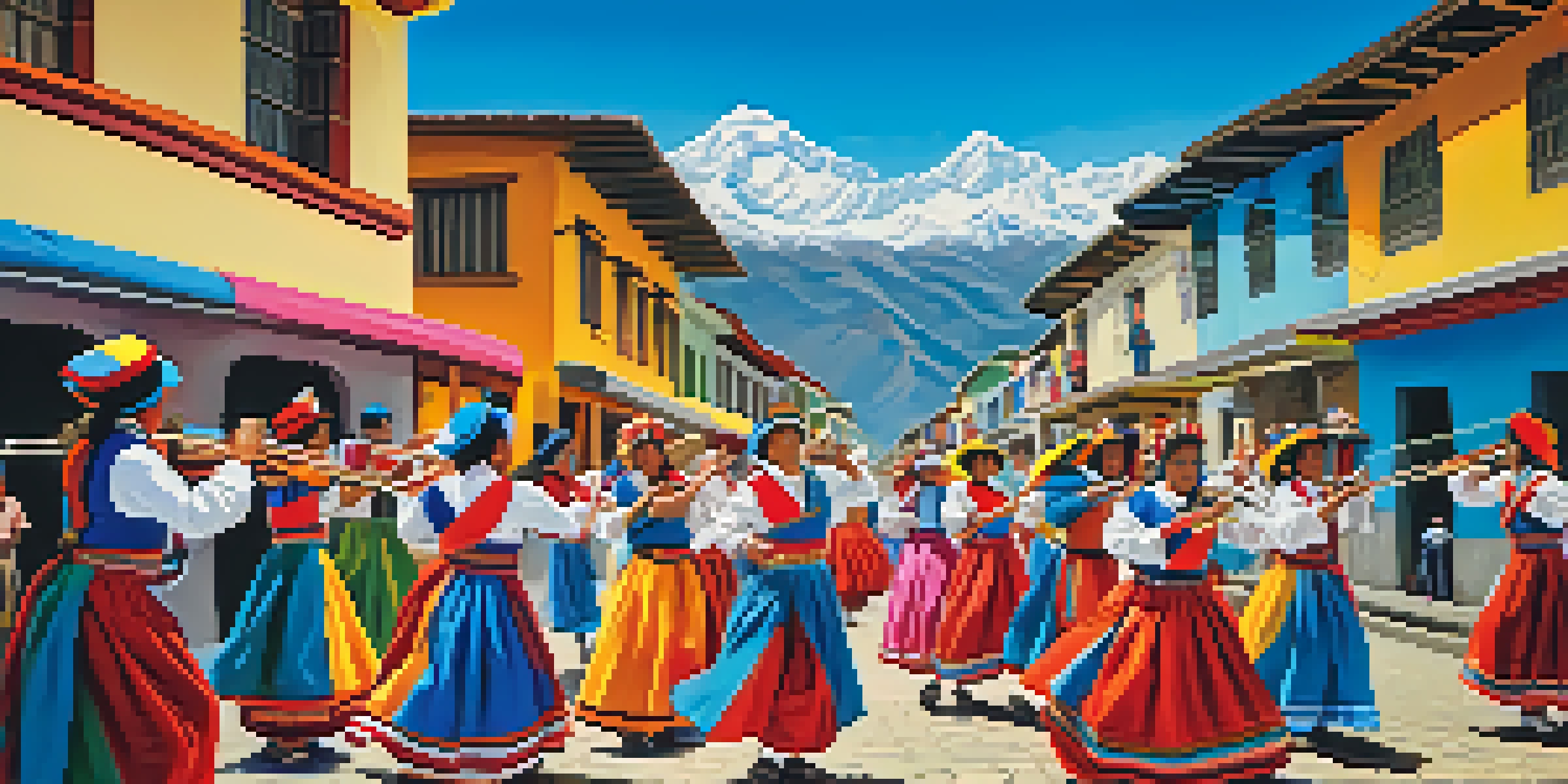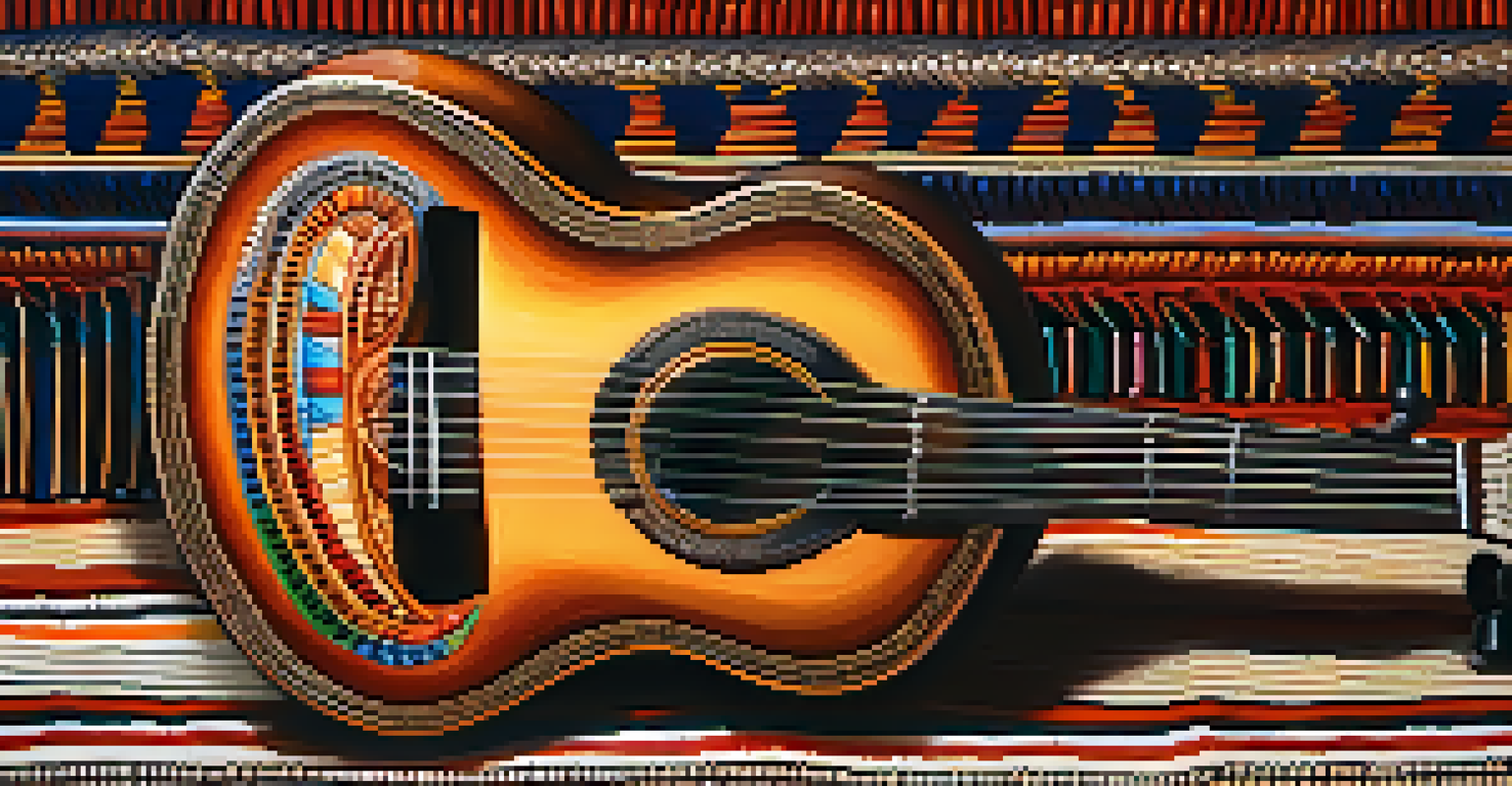Peruvian Folk Music: A Reflection of Cultural Heritage and Identity

The Roots of Peruvian Folk Music and Its Origins
Peruvian folk music is a vibrant tapestry woven from the diverse cultures that inhabit the Andes, Amazon, and coastal regions. Its roots can be traced back to ancient civilizations, such as the Incas, who used music as a means of storytelling and cultural expression. Over the centuries, this music has absorbed influences from Spanish colonization, African rhythms, and indigenous traditions, creating a unique sound that reflects Peru's multifaceted identity.
Music is the shorthand of emotion.
Instruments like the charango, pan flute, and cajón are integral to traditional Peruvian music, each carrying its own historical significance. The charango, for instance, is a small stringed instrument made from armadillo shells, symbolizing the connection to the Andean landscape. Such instruments not only create the melodies that resonate with the people but also serve as a reminder of the country’s cultural heritage.
As we delve into the various styles of Peruvian folk music, we see how each region offers a distinct flavor that contributes to the national identity. From the lively huaylas of the Andean mountains to the soothing marinera of the coast, these musical styles tell stories of love, struggle, and celebration, all while preserving the essence of Peruvian culture.
Traditional Instruments: The Heartbeat of Peruvian Music
The diverse range of instruments used in Peruvian folk music plays a crucial role in shaping its unique sound. The cajón, a box-shaped percussion instrument, originated from African slaves and is now a staple in many genres, including flamenco and jazz. Its rhythmic beats have become synonymous with Peruvian identity, resonating with the heartbeat of the nation.

Another iconic instrument is the pan flute, known locally as the 'zampona,' which is crafted from bamboo tubes of varying lengths. This instrument carries the haunting melodies of the Andes, often evoking feelings of nostalgia and connection to the earth. The sound of the zampona can transport listeners to the highlands, allowing them to experience the landscapes and traditions of the region.
Cultural Heritage Through Music
Peruvian folk music is a vibrant expression of the country's diverse cultural roots, blending ancient traditions with modern influences.
Finally, the charango, with its bright, cheerful tones, adds a joyful spirit to folk music performances. Traditionally made from the shell of an armadillo, this instrument embodies the resourcefulness and creativity of the Peruvian people. Together, these instruments not only enrich the music but also serve as cultural artifacts that tell the story of Peru’s diverse heritage.
The Role of Dance in Peruvian Folk Music
Dance is an inseparable part of Peruvian folk music, enhancing the emotional depth of the melodies. Each folk dance has its own rhythm and story, bringing communities together in celebration of life and culture. For example, the marinera, a graceful dance characterized by handkerchiefs, symbolizes courtship and is often performed during festivals and competitions.
The only truth is music.
In contrast, the huaylas, with its lively footwork, reflects the agricultural traditions of the Andean peoples. Dancers often mimic the movements of planting and harvesting, paying homage to the land that sustains them. This connection between dance and daily life emphasizes the importance of cultural practices in maintaining a sense of identity.
Through dance, the stories behind the music come to life, creating a shared experience that fosters community bonds. Whether it's a solemn ritual or a vibrant festival, the dances associated with Peruvian folk music provide insight into the values and traditions that define the nation.
Regional Variations: A Journey Through Peru’s Music
Peru's geographical diversity gives rise to distinct regional variations in folk music, each with its own unique characteristics. The highlands boast the melancholic sounds of the Andean music, often featuring themes of nature and spirituality. Meanwhile, coastal regions embrace the marinera and afro-peruvian rhythms, creating a rich blend of influences that showcase Peru's multifaceted culture.
In the Amazon, indigenous tribes contribute their own unique sounds, using traditional instruments like the bomba and maracas. Their music often reflects their deep connection to nature and the stories of their ancestors, highlighting the importance of preserving these traditions in a rapidly changing world. Each region tells a different story, yet they all come together to form the larger narrative of Peruvian folk music.
Regional Diversity in Sound
Each region of Peru contributes unique musical styles, reflecting local traditions and stories that enrich the nation's cultural identity.
Exploring these regional differences not only enriches our understanding of Peruvian culture but also celebrates the diversity that exists within the nation. It reminds us that while the music may vary, the underlying themes of love, resilience, and identity remain constant across the country.
The Influence of Modernity on Peruvian Folk Music
As Peru continues to evolve, so does its folk music, which increasingly incorporates modern influences while maintaining traditional roots. Contemporary artists are blending genres such as rock, pop, and electronic music with traditional sounds, creating a vibrant fusion that appeals to younger audiences. This evolution reflects the dynamic nature of cultural identity in a globalized world.
However, this fusion isn’t without its challenges. Some purists argue that blending traditional music with modern elements can dilute its authenticity. Yet, many artists see this as an opportunity to breathe new life into folk music, ensuring that it remains relevant for future generations. They aim to strike a balance between honoring tradition and embracing innovation.
Ultimately, the influence of modernity on Peruvian folk music serves as a testament to its resilience and adaptability. By navigating the space between tradition and innovation, artists are not only preserving their cultural heritage but also paving the way for a new generation to connect with their roots.
Peruvian Folk Music as a Tool for Cultural Preservation
In a world where globalization threatens to overshadow local cultures, Peruvian folk music plays a crucial role in preserving cultural heritage. Many communities actively engage in initiatives to teach traditional music to younger generations, ensuring that their cultural identity remains vibrant. Through workshops and community events, the essence of folk music is kept alive, fostering pride in their roots.
Organizations and cultural festivals dedicated to Peruvian folk music also contribute to this preservation effort. Events such as the Festival de la Marinera not only showcase traditional dances and music but also emphasize the importance of cultural pride. These gatherings serve as a reminder of the unique identity that unites Peruvians, regardless of their background.
Global Influence of Peruvian Music
Peruvian folk music transcends borders, captivating international audiences and inspiring collaborations that celebrate cultural diversity.
Through education and celebration, folk music becomes a living tradition, allowing communities to share their stories and values. In doing so, they reinforce the significance of their heritage, making it accessible and relevant to future generations, ensuring that the heart of Peru's cultural identity continues to beat strongly.
The Global Impact of Peruvian Folk Music
Peruvian folk music's influence extends far beyond the borders of the country, captivating audiences around the globe. Artists like Susana Baca and Los Kjarkas have introduced the rhythms and melodies of Peru to international stages, showcasing the richness of their cultural heritage. This exposure not only celebrates their artistry but also fosters a greater appreciation for the diversity of world music.
As global interest in world music rises, Peruvian folk music finds its way into various genres and collaborations. Musicians from different backgrounds are increasingly incorporating traditional Peruvian instruments and styles into their work, creating a beautiful blend of cultures. This fusion highlights the universal themes of love, struggle, and identity that resonate with audiences worldwide.

Through this global exchange, Peruvian folk music inspires a deeper understanding of cultural connections. It serves as a reminder that while we may come from different backgrounds, the stories we share through music can unite us, transcending borders and enriching the human experience.